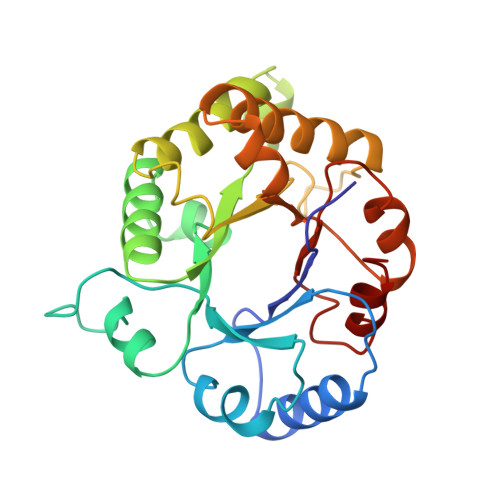The crystal structure of the "open" and the "closed" conformation of the flexible loop of trypanosomal triosephosphate isomerase.
Wierenga, R.K., Noble, M.E., Postma, J.P., Groendijk, H., Kalk, K.H., Hol, W.G., Opperdoes, F.R.(1991) Proteins 10: 33-49
- PubMed: 2062827
- DOI: https://doi.org/10.1002/prot.340100105
- Primary Citation of Related Structures:
3TIM - PubMed Abstract:
Triosephosphate isomerase has an important loop near the active site which can exist in a "closed" and in an "open" conformation. Here we describe the structural properties of this "flexible" loop observed in two different structures of trypanosomal triosephosphate isomerase. Trypanosomal triosephosphate isomerase, crystallized in the presence of 2.4 M ammonium sulfate, packs as an asymmetric dimer of 54,000 Da in the crystallographic asymmetric unit. Due to different crystal contacts, peptide 167-180 (the flexible loop of subunit-1) is an open conformation, whereas in subunit-2, this peptide (residues 467-480) is in a closed conformation. In the closed conformation, a hydrogen bond exists between the tip of the loop and a well-defined sulfate ion which is bound to the active site of subunit-2. Such an active site sulfate is not present in subunit-1 due to crystal contacts. When the native (2.4 M ammonium sulfate) crystals are transferred to a sulfate-free mother liquor, the flexible loop of subunit-2 adopts the open conformation. From a closed starting model, this open conformation was discovered through molecular dynamics refinement without manual intervention, despite involving C alpha shifts of up to 7 A. The tip of the loop, residues 472, 473, 474, and 475, moves as a rigid body. Our analysis shows that in this crystal form the flexible loop of subunit-2 faces a solvent channel. Therefore the open and the closed conformations of this flexible loop are virtually unaffected by crystal contacts. The actual observed conformation depends only on the absence or presence of a suitable ligand in the active site.
Organizational Affiliation:
European Molecular Biology Laboratory, Heidelberg, Federal Republic of Germany.














